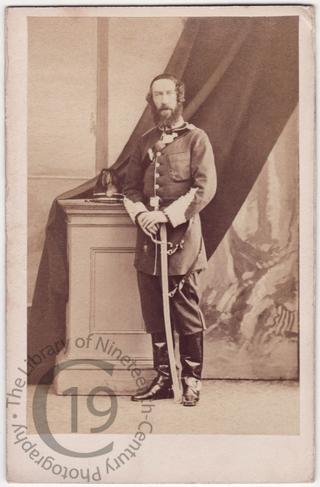
Lord Ranelagh
A carte-de-visite portrait of Thomas Heron Jones (1812-1885), from 1820 the 7th Viscount Ranelagh. In 1868 he was a key witness in the trial of ‘Madame Rachel,' a notorious cause célèbre of the day.
Madame Rachel (real name Sarah Rachel Leverson) lived on the corner of New Bond Street and Maddox Street in a fashionable quarter of London and sold various ointments, powders and cosmetics that she claimed would make any woman ‘beautiful for ever.' One of her customers was a Mrs Borrodaile, the widow of a colonel, who on her first visit in 1864 spent £10 but ended up parting with in excess of £5000 over the following months.
During the course of her treatments Madame Rachel (or ‘Granny,' as she invited her clients to call her) told Mrs Borrodaile that another of her clients, Lord Ranelagh had spied her from afar and fallen in love with her, but because of the difference in their social status, he would have to communicate with Mrs Borrodaile by letter. A stream of love letters ensued, in which Lord Ranelagh urged the object of his affections to continue with her treatments and to put herself entirely in Granny’s hands. When the dupe eventually grew suspicious and questioned why the letters were sometimes in different hand-writing, she was told that Lord Ranelagh had hurt his hand and had therefore dictated some letters. When Mrs Borrodaile questioned why he had on different occasions signed his letters with different Christian names, she was told that he was protecting his identity should the letters fall into the wrong hands. A proposal of marriage was made and accepted, and Mrs Borrodaile handed over further funds to buy lace and carriages for the wedding, and even made over £1600 in bonds to the groom.
Finally, this tissue of lies proved too implausible for even the gullible Mrs Borrodaile and realising that she had been swindled she went to Marlborough Street police station and filed a complaint. The resulting trial provided newspaper readers with much amusement. Lord Ranelagh appeared as a witness, and unsurprisingly turned out never to have set eyes on Mrs Borrodaile in his life. When asked what business he had had going to Madame Rachel’s premises in the first place, his evasive answer was ‘You don’t suppose I went there to be enamelled.' (The rumour at the time was that he went to have his moustache dyed, though there was also a suspicion that he had attended the salon to spy on women in a state of undress.)
The outcome of the trial was that Madame Rachel got five years penal servitude in Newgate
Photographed by Caldesi, Blanford and Co of London.
Code: 123928




